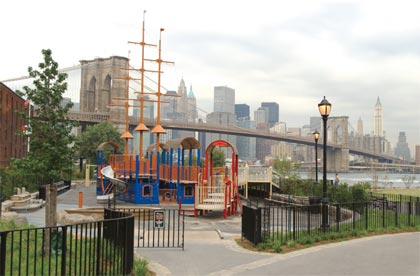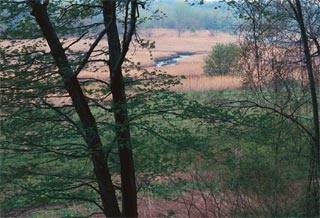Parks & Recreation 2002-2003 Biennial Report
Eight Seasons of Progress
Connecting People with the Waterfront

Ah, what can ever be more stately and admirable to me than mast-hemmed Manhattan? River and sunset and scallop-edged waves of flood-tide?
Walt Whitman
"Crossing Brooklyn Ferry," 1900
NEW YORK CITY’S WATERFRONT is our last untapped open space. During the boom years of maritime industry, the waterfront was used for transport and trade, while parks were developed primarily in the city’s interior. Now, commercial interests no longer dominate city shores, and the idea of the waterfront as a public space for recreation has captivated the attention of New Yorkers.
Mayor Bloomberg has made restoring our city’s waterfront a top priority. In 2002 and 2003, we developed waterfront parks in every borough in tandem with other city and state agencies and through entities such as the Brooklyn Bridge Park Development Corporation, the Hudson River Park Trust, and the Riverside South Planning Corporation. New Yorkers and visitors alike have flocked to these parks, taking in their expansive new vistas and enjoying some of the best examples of contemporary park design.
MIDLAND BEACH PIER
The new $9 million Midland Beach Pier in Staten Island provides peaceful escape in a city defined by motion. At 835 feet long and with 30,000 square feet, it is New York City’s largest recreational pier on the Atlantic Ocean. Visitors can now taste the salty air, feel the ocean breeze, and meander amidst fishermen and sunbathers.
MANHATTAN GREENWAY
In 2003, we led the effort to open the Manhattan Waterfront Greenway, investing 6.5 million in construction and signage. The Greenway runs a total of 32 miles around our skyscraping metropolis, with interim inland detours bypassing waterfront obstacles. The Greenway was the product of many partners: the City and State Departments of Transportation, the Department of City Planning, the Economic Development Corporation, and the Hudson River Park Trust. This is only the beginning; we are building new greenway sections in East and West Harlem, and in Riverside and East River Parks.

- New York City has 578 miles of waterfront, one third of which is parkland.
- Parks & Recreation manages 12 marinas and more than 1,200 boat slips.
- Since 2002, Parks & Recreation has bolstered its local summer lifeguard staff with international lifeguards.
- In 2003, Parks & Recreation gave canoe and kayak lessons to more than 2,500 New Yorkers.
BROOKLYN BRIDGE PARK
We transformed a parking lot on Brooklyn’s industrial waterfront into a beautiful overlook along the East River. With its scenic views of both the Manhattan and Brooklyn Bridges, its nautical playground, wildflowers, and wide steps cascading to native shoreline plantings, the park has become a popular destination. This $6.6 million park is the first step in a state and city collaboration to develop a 1.3-mile waterfront park embracing Vinegar Hill, Fulton Ferry, and Brooklyn Heights.
WETLAND RESTORATIONS
In 2002 and 2003, Parks & Recreation restored 13 acres of wetland and surrounding parkland at a cost of over $2.5 million. We completed restoration projects along the Bronx River and Jamaica Bay, developing new techniques to restore degraded natural shorelines. The industrial ruins of a cement plant now serve as a backdrop for grassy new wetland along the Bronx River. At Four Sparrow Marsh in Brooklyn, we rejuvenated the natural ecosystem, establishing a healthy tidal salt marsh.
LOOKING AHEAD
The past two years of development are just the first wave in the transformation of the waterfront. We are developing greenways in Queens, Brooklyn, and Staten Island, and along the Bronx shore of the Harlem River. Not long from now, New York City will be known for the serene views from its surrounding shoreline, in addition to the green spaces in its interior.
